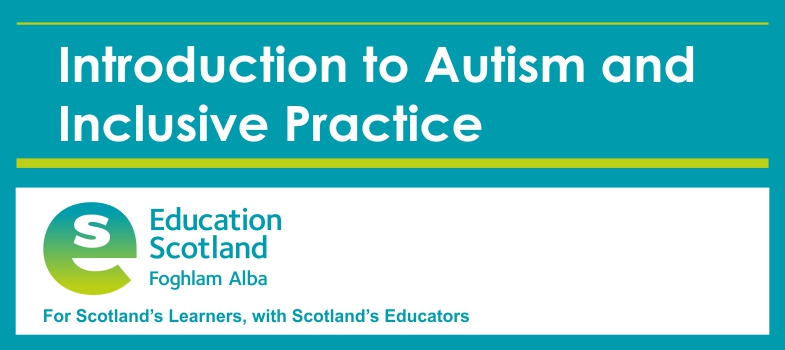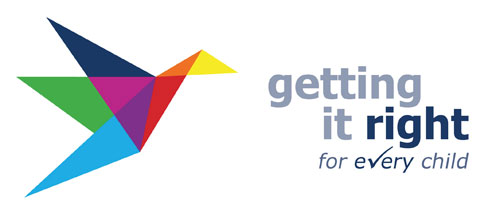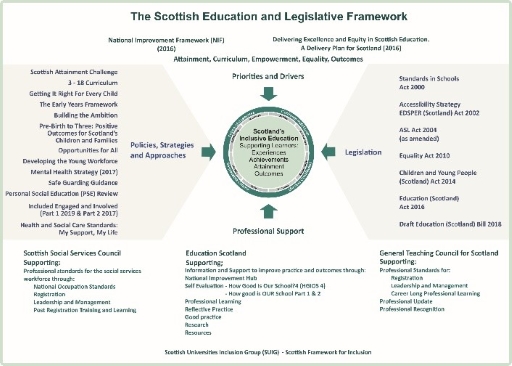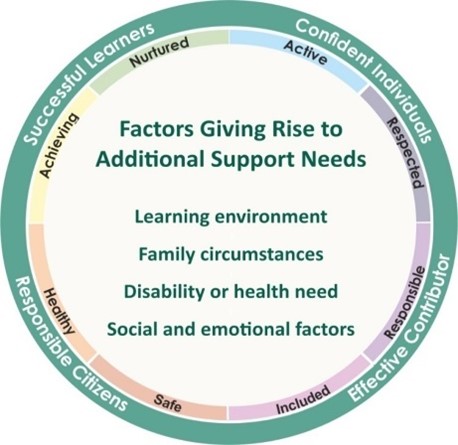2.2 Legislative and policy frameworks
Legislation which places duties on schools and local authorities to support and provide inclusive education for learners in Scotland can be linked directly to the United Nations Convention on the Rights of the Child (UNCRC).
Our legislation ensures rights and entitlements for children and young people to education, support and wellbeing. There is a range of legislation and educational policies that places duties and expectations on schools and local authorities to ensure that they:
- promote a child centred approach to encourage every child to reach their ‘fullest potential’
- deliver an inclusive education
- support learners to achieve to the best of their ability
- do not discriminate against those with protected characteristics
- provide assessments when requested.
Within the ‘Getting it right for every child’ framework, there is an expectation that partnership working will ensure that children receive the right support at the right time from the right people. This includes families, education, social work, health and third-sector partners. Services need to work together in a coordinated way to meet the specific needs and improve the wellbeing of all children and young people.
Curriculum for Excellence
Curriculum for Excellence places learners at the heart of education. At its centre are four fundamental capacities. These capacities reflect and recognise the lifelong nature of education and learning. The four capacities are aimed at helping all children and young people, including autistic learners, to become:
- successful learners
- confident individuals
- responsible citizens
- effective contributors.
The purpose of the curriculum is encapsulated in the four capacities above.
The curriculum aims to ensure that all children and young people in Scotland develop the knowledge, skills and attributes they will need if they are to flourish in life, learning and work, now and in the future, and to appreciate their place in the world.
See the attributes and capabilities of the four capacities [Tip: hold Ctrl and click a link to open it in a new tab. (Hide tip)]
See further information on Curriculum for Excellence and the Refreshed Narrative
Figure 6 below provides a more detailed overview of the national legislation and policy that underpins the Scottish educational context of inclusion and equality. It is not intended as an exhaustive list of all Scottish policy which refers to inclusion but gives a broad overview of some of the key legislation and policy documents.
Download a copy of The Scottish Context – detailed image
Looking at policy and legislation through the autism lens
Scottish legislation outlines a framework for all children to be supported, where necessary, to make sure they benefit from education and reach their full potential. This includes all learners who require additional support, for example, autistic learners. In Scotland, the term ‘Special Educational Needs’ is no longer used. Since 2004, we have used the term broad term ‘Additional Support’, which means:
any child who needs more or different support to what is normally provided in schools or pre-schools (from age 3) is entitled to additional support to overcome barriers to learning.
The legislation clearly states that an additional support need can arise for any reason and be of short- or long-term duration. Additional support may be required to overcome needs arising from learning environment, health or disability, family circumstances, or social and emotional factors as highlighted in Figure 7.
Autistic learners can require support across three factors: learning, disability, and social and emotional. The 2020 independent review of the implementation of the additional support for learning legislation highlighted the interconnection between the factors that give rise to additional support needs and that they are:
‘not mutually exclusive. This Review heard about increasing numbers of children and young people where issues due to Autism Spectrum Disorder (ASD) are compounded by social, emotional, behavioural problems linked to poverty and inequality’.
It is highly likely that all educational staff will work with and support an autistic learner at some stage. With this in mind, it is important for all staff to have an awareness of their professional duties and legislation with regards to inclusion and an understanding of how to support autism.
The Scottish Autism Strategy
The Scottish Strategy for Autism was created in 2011 to ensure that progress is made across Scotland in delivering quality services for children and adults on the autism spectrum. This is a ten-year national strategy for autism that addresses the entire autism spectrum and the whole lifespan of people living with autism spectrum disorder (ASD) in Scotland.
The Scottish Autism Strategy vision
Our vision is that individuals on the autism spectrum are respected, accepted and valued by their communities and have confidence in services to treat them fairly so that they are able to have meaningful and satisfying lives
Recent policies and legislation
You will need to download this file.
Download the summary of the Scottish Educational Legislative and Policy Framework, which provides an overview of the legislation and policies listed below.
- United Nations Rights of the Child (UNCRC)
- Disability Strategies and Pupils’ Educational Records (2002)
- Curriculum for Excellence
- Additional Support for Learning (Scotland) Act 2004 (as amended 2009) (ASL ACT)
- Code of Practice to support the ASL ACT
- Equality Act (2010)
- The Scottish Autism Strategy (2011–2018)
- ‘Getting it right for every child’ approach
- National Improvement Framework
- Scotland Delivery Plan
- Children and Young People Act (2014)
- Education (Scotland) (2016)
- Autism and the Equality Act (2010)
Activity 3
Autism and the Equality Act (2010)
Go to the Autism Lens on Policy and Legislation page on the Autism Toolbox to watch the film in which a Senior Policy and Insight Officer explains what the Equality Act means in practice when we are supporting autistic learners. There is an exploration of autism and disability and topics such as exclusions, reasonable adjustments for school trips or sports days, and after school clubs.
The link is also available on Education Scotland’s YouTube channel.
2.1 The Scottish context




